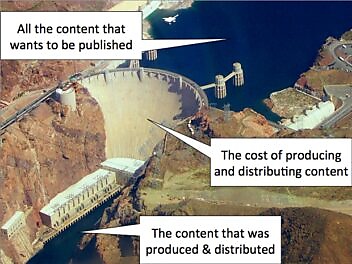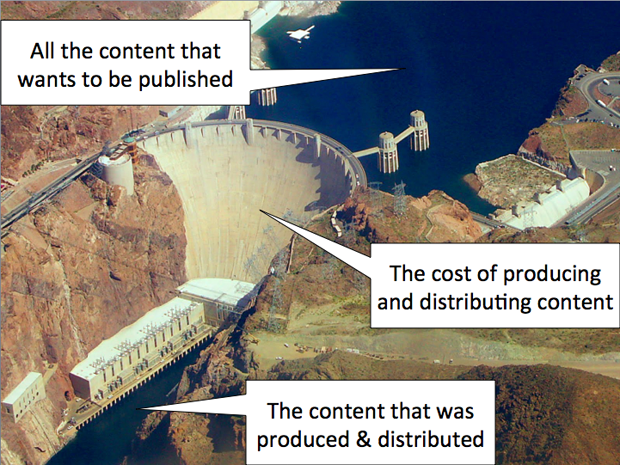For readers, there is no quality content problem. For publishers, there is a quality content problem.
We are awash in content.
And, even though Google’s pulling out all the stops (ahem, panda) to help us find just the content we want, it’s not enough.
I’m not complaining. Information’s far more available than ever before. And the democratization of media has led to a better world.
However, it’s hard to deny that finding information (real insight) has required us to wade through far more garbage than we were ever accustomed to before, from libraries, newsstands, peers or the airwaves.
The filter issue’s been discussed before, I know. And entrepreneurs are racing to use social, user-generated, user intent or any other signal they can to help filter things intelligently. It’s working, if not perfectly.
But that’s seeing things from the user’s perspective, not the publisher’s. It turns out publishers need filters too. The problem of quality content is not really a user-problem. It’s a publisher problem.
When the cost of information distribution drops to zero, the only barrier between publishing quality content and publishing…well, shit, is self-imposed.
This lesson’s hard won. Publishers glue their eyes to Google Analytics. Ad-driven publishers obsess over pageviews (CPM). And brand publishers over prospects and leads. “More, more, more!” goes the cry.
One retired tech blogger wrote ruminatively from his time in the eye of this storm: “People read these stories as if they’re definitive posts full of insightful information. Ha. Most of them are bullshit.”
Hyperbole? No, not really.
And anyone from the world of new media publishing (bloggers, digital marketers, etc.) who makes this point, meets a chorus of spite and anger from within the ecosystem. Other bloggers and digital marketers who make their living from “more, more, more!” don’t want to hear it.
It’s enough to make this digital marketer want to tell companies “don’t blog, don’t tweet, don’t do ebooks, infographics, guest posts or videos” just so he doesn’t fall into the “at any cost, more, more, more!”-crowd.
By all means, though, do more – quality. That’s the thing in this content market. The quality model’s a bit busted. I mean, readers still recognize it, and reward it (over time). But marketers since the age of Crassus have had a relatively deaf ear to what readers really want, haven’t they?
In both media and marketing, this old quality model used to hold us in decent stead:
At least, it meant that a fair amount of dross that would otherwise be published, wasn’t published. There was a barrier, either economic or editorial (which eventually meant economic, as well), to publishing just anything.
That content economy is history. That dam is gone.
It’s hard to argue against the new model, however. Wishing for a return to the era of the dam is a kind of media fascism (when the uneducated masses weren’t allowed to broadcast their uneducated thoughts). I’m definitely not a media fascist.
But I love quality content. So where am I?
Back to the story of the filter, but rather than the reader-filter, the publisher-filter. It’s time for anyone publishing online (be it an ad-driven blog or marketing automation-driven software vendor) to clean out his or her filter. It’s the new differentiator.
[I’ll focus solely on marketers and brands from here on out – not pageview-driven ad-based publishers.]
Pre-online publishing, blogging and social media, those brands that could publish, were publishers enough. If the magazines they printed out were readable, so much the better. Just the ability to publish, though, was evidence enough of strength and quality.
Now anyone can publish. Pushing out a blog with daily posts (twice daily! three times!) is evidence of nothing. Big deal. You can tap keys and string along some keywords. A shining standard of quality this does not make.
Unfortunately, and here’s the real kicker, and the cause for my rant, quality content does not rise by itself online. A brand that pushes out a masterpiece may meet…crickets. The horror.
As an agency, it’s a problem. We are hired to create feats of content greatness, to show content virtue above and beyond the call of duty. And, I’m proud to say, I think we do 99.9% of the time, thanks to good processes, good leadership and good standards. I would say that, but it’s true goddammit.
So when we make some great content and it doesn’t take off for a client, we’re upset. They’re upset. Not high fives all around.
It’s easy to blame the client here. To say that they’ve either not made the necessary investment to build any audience online so far, or spoiled that audience with previous crap content. That may or may not be the case.
But the fact remains that, in an environment where very powerful user filters have replaced publisher filters, great content can sink. Why is this? If even one person found the content great (and surely even one person finds just about anything online these days), he’ll share it and it’ll go viral, right? No.
In a world where every man is his own editor, we’ve all become very good source critics. That is, we’ve become incredibly adept at judging content’s quality based on the authority of the publisher (hell, that’s google’s entire business model).
Therefore, if someone reads something interesting on a site that they’ve never heard of or know, they’re likely to dismiss it regardless of what they see or read there. Domain authority, in other words, determines all, or almost.
This is nothing new. In college, my professor of English Stanley Fish loved to tease us post-grads and English majors with the following challenge: Submission-blind academic journals are wrong because something I write, by definition, holds more authority than something you write.
Or to put it in a more dramatic way – if you saw a mathematical proof claiming “2+2=5”, are you more likely to read it if it was written by a Ph.D. in theoretical physics or a 10-year-old?
To return to digital marketing, the only way you’ll get the authority commanded by quality content (getting through users’ filters) is to publish great content, repeatedly, consistently and over time. Authority accumulates slowly.
There’s a quality content problem in digital marketing because this publisher-driven filter fails much of the time. Driven by mobs of the more click-rabid variety of digital marketers, companies abandon the kind of discipline needed to attain authority.
Thus, my conclusion: The real differentiation in content marketing 2.0, or whatever you want to call the grown-up age of content marketing? Self-discipline.
Are you self-disciplined? Or are you in the “more, more, more!” mob?

Enjoyed this article?
Take part in the discussion









Comments
There are no comments yet for this post. Why not be the first?